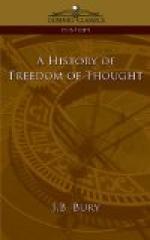[192] way, undermined by historical criticism, which has been more deadly than the common-sense criticism of the eighteenth century.
The methodical examination of the records contained in the Bible, dealing with them as if they were purely human documents, is the work of the nineteenth century. Something, indeed, had already been done. Spinoza, for instance (above, p. 138), and Simon, a Frenchman whose books were burnt, were pioneers; and the modern criticism of the Old Testament was begun by Astruc (professor of medicine at Paris), who discovered an important clue for distinguishing different documents used by the compiler of the Book of Genesis (1753). His German contemporary, Reimarus, a student of the New Testament, anticipated the modern conclusion that Jesus had no intention of founding a new religion, and saw that the Gospel of St. John presents a different figure from the Jesus of the other evangelists.
But in the nineteenth century the methods of criticism, applied by German scholars to Homer and to the records of early Roman history, were extended to the investigation of the Bible. The work has been done principally in Germany. The old tradition that the Pentateuch was written by Moses has been completely discredited. It is now
[193] agreed unanimously by all who have studied the facts that the Pentateuch was put together from a number of different documents of different ages, the earliest dating from the ninth, the last from the fifth, century B.C.; and there are later minor additions. An important, though undesigned, contribution was made to this exposure by an Englishman, Colenso, Bishop of Natal. It had been held that the oldest of the documents which had been distinguished was a narrative which begins in Genesis, Chapter I, but there was the difficulty that this narrative seemed to be closely associated with the legislation of Leviticus which could be proved to belong to the fifth century. In 1862 Colenso published the first part of his Pentateuch and the Book of Joshua Critically Examined. His doubts of the truth of Old Testament history had been awakened by a converted Zulu who asked the intelligent question whether he could really believe in the story of the Flood, “that all the beasts and birds and creeping things upon the earth, large and small, from hot countries and cold, came thus by pairs and entered into the ark with Noah? And did Noah gather food for them all, for the beasts and birds of prey as well as the rest?” The Bishop then proceeded to test the accuracy of the inspired books by examining
[194] the numerical statements which they contain. The results were fatal to them as historical records. Quite apart from miracles (the possibility of which he did not question), he showed that the whole story of the sojourn of the Israelites in Egypt and the wilderness was full of absurdities and impossibilities. Colenso’s book raised a storm of indignation in England—he was known as “the wicked bishop”; but on the Continent its reception was very different. The portions of the Pentateuch and Joshua, which he proved to be unhistorical, belonged precisely to the narrative which had caused perplexity; and critics were led by his results to conclude that, like the Levitical laws with which it was connected, it was as late as the fifth century.




